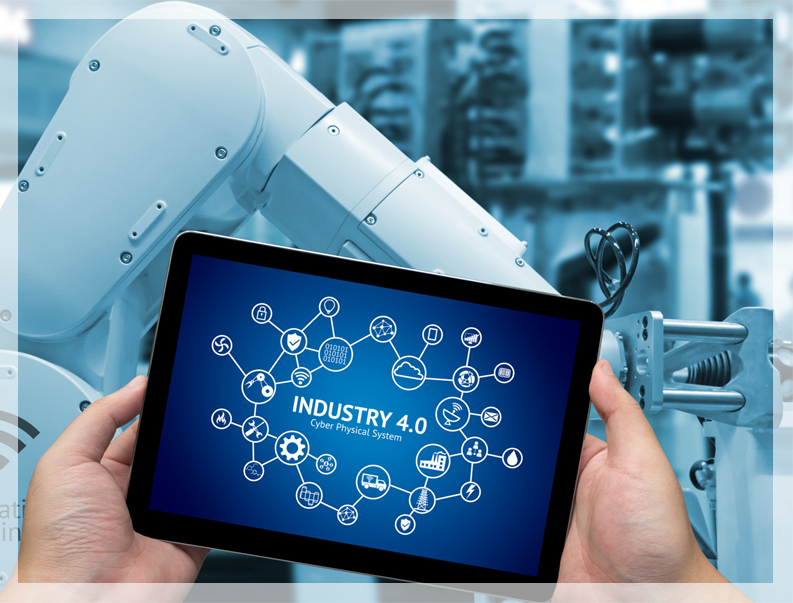Industrial Revolution 4.0

Fourth Industrial Revolution - adding value, delivering results
The Fourth Industrial Revolution (or Industry 4.0) is the ongoing automation of traditional manufacturing and industrial practices, using modern smart technology. Large-scale machine-to-machine communication (M2M) and the internet of things (IoT) are integrated for increased automation, improved communication and self-monitoring, and production of smart machines that can analyze and diagnose issues without the need for human intervention.


changing manufacturing
Industry 4.0 is revolutionizing the way companies manufacture, improve and distribute their products. Manufacturers are integrating enabling technologies, including Internet of Things (IoT), cloud computing and analytics, and AI and machine learning into their production facilities and throughout their operations. These smart factories are equipped with advanced sensors, embedded software and robotics that collect and analyze data and allow for better decision making.
The fourth industrial revolution will be marked by the digitization of manufacturing and the computerization of industry.
Below are listed important components that will revolutionise the industry. For example, smart and autonomous systems backed by big data and machine learning will make manufacturing and shipping more seamless and efficient than ever.
Big Data Analytics –
Big data analytics are analytics that will be able to analyze and collect useful insights from vast quantities of data. Big data analytics are improving all the time and will be more heavily used in Industry 4.0.
3D technology –
3D technology is an emerging sector that is being embraced by business nowadays, to improve the shopping experience as well as to simplify the working process, applications of 3d technologies include 3D modeling, 3D printing, 3D visualization, 3D display and so on.
Smart factory –
Factories that rely on advanced technologies like robotics, big data processing, cloud computing, strong cybersecurity and smart sensors to be highly efficient, secure and cost-effective.
Internet of Things (IoT) platforms –
The Internet of Things refers to all devices that can collect data, transmit it over the internet, and communicate with other devices. Smart refrigerators, lamps, and toasters are all examples of IOT devices.
Location detection technologies –
These technologies detect your location and are commonly found on mobile devices. You can share your location with trusted people using location detection technologies.
Advanced Algorithms –
Advanced algorithms are highly complicated mathematical formulas that provide instructions for computer systems to follow in order to make sure that various tasks are completed.
Augmented reality/ wearables –
This refers to wearable technology, such as Google Glass that augment reality with visual data.
Smart Sensors –
Smart sensors are sensors that are capable of capturing information, processing it, and giving a digital signal when the time is right.
Data Visualization –
Data visualization is when data is expressed in visual forms such as infographics, charts, maps, and more. In the future, larger quantities of data will be able to be visualized and it will be able to be expressed in more forms.
Authentication and Fraud Detection –
This technology involves the use of big data and pattern recognition in order for parties to tell when fraud is occurring. Banks and financial institutions will use this technology more heavily in the future.
Blockchain Technology –
Blockchain technology is a technology that originated from Bitcoin, the famous digital currency. This technology involves information being stored on universal public ledgers in the form of “blocks” that are connected to each other on a “chain” and being validated by “miners.”
Multi-level Customer Interaction and Customer Profiling –
This technology involves organizing customers into groups based on certain identifiers. These identifiers can include hobbies, age, location, interests, etc.
Cloud Computing –
Cloud computing is computing that does not rely on local servers, desktops or laptops for data storage. Instead, cloud computing relies on “the cloud,” which is shared storage that is located in a remote area.
Advanced Human-Machine Interfaces –
Advanced human-machine interfaces are interfaces on machines that provide visual data about the functions the machine is carrying out so that operators can understand how the machine is performing in real-time.
Mobile Devices –
Mobile devices include smartphones, tablets, laptops, e-readers, smart watches, handheld gaming consoles, and any other devices that people carry around to access the internet with. These devices will be a key component of industry 4.0 and they will be ubiquitous.